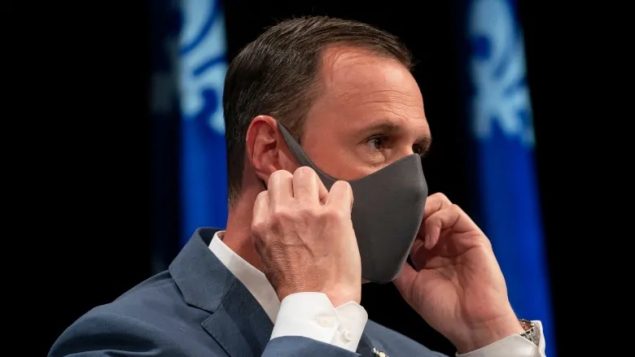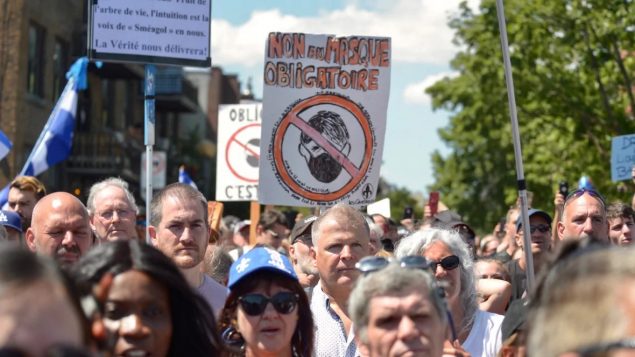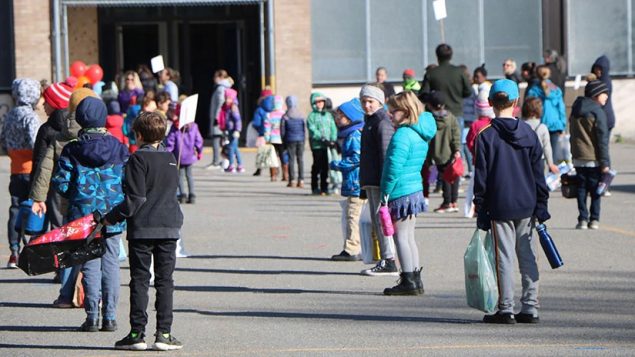In the government’s second kick at the can, Quebec has unveiled new rules as students–and parents–get set for a return to school in September.
The updated back-to-school regulations were announced Monday by Education Minister Jean-Francois Roberge.
Among other things, they require students in Grade 5 and up to wear masks in all common areas of school buildings, except classrooms.
The mask rule, Roberge said, will apply to older elementary students, high school students and people in vocation training or adult education in the school hallways and moving around inside school.

Quebec Education Minister Jean-François Roberge announced details of the province’s updated back-to-school plan on Monday. (Ivanoh Demers/Radio-Canada)
But, once inside the classroom, the mask rule will not apply, as the province backtracked on the idea of so-called “bubbles” containing six students.
Roberge said each classroom will be its own bubble, and students will not be required to maintain a two-metre distance with their classmates.
Teachers and staff will have to wear masks, but Roberge said they will not be mandatory in the classroom because of the challenge they present to face-to-face communication.
And, he said, while all elementary and high school students will be expected to return to school at the end of the month, children with significant health problems will be offered a remote learning option.
As well, Roberge said remote learning options for children who are at risk must be available with a note from from a doctor mandatory to pass on in-person classes.
“Your children have the right to be taught at home,” he said.
IT WAS A SUMMER OF MUCH HEATED DEBATE IN QUEBEC
Roberge’s Monday press conference was a long time coming, as parents, politicians and educators debated the best path forward in the age of COVID-19 through much of the summer.
In June, Roberge announced that elementary and high school students across the province would be required to return to class, saying attendance would be mandatory for all elementary and high school students, with physical distancing measures in place.
For weeks, parents, teachers unions and the opposition criticized the government for what they called a lack of clarity, as they expressed concerns that the initial set of guidelines did not go far enough.
Last week, a group of parents engaged constitutional lawyer Julius Grey to issue a letter to the Quebec minister of education, outlining the need for an online schooling option for families that are uncomfortable with sending their children back to school.
Roberge said Monday the government’s new strategy aims to make communication between teachers and students as easy as possible.

Students outside the greater Montreal area went back to school briefly in the spring. In just a few weeks, they will be back in classrooms. (Ryan Remiorz/THE CANADIAN PRESS)
Under the updated guidelines, once a student has tested positive for COVID-19, all parents and staff members of the school must be notified as soon as possible.
“If the case is in your child’s classroom, you will know. If it’s in your child’s school, you will be informed,” Roberge said.
“We have nothing to hide.”
An infected child will then need to isolate themself at home before being readmitted to class. During that time, the student will have to do schoolwork from home.
Anyone deemed to be at moderate to high risk of exposure to the infected student will also be sent home and be required to be tested.
Any student who shows symptoms of COVID-19 will be escorted out of the school by a staff member wearing protective equipment who will wait with them until a relative arrives.
If a child develops symptoms at home, it will be up to the parents to ensure they stay at home and contact Quebec public health.

Protesters in Montreal carried signs on Saturday, indicating a variety of motivations and ideologies in opposition to face coverings. (Jean-Claude Taliana/Radio-Canada)
At the time, the goverrnment did not masks mandatory for students but did require face coverings for preschool teachers, special-needs teachers and vocational training teachers, as well as for staff during certain situations that require close contact.
The directive applied to people aged 12 and older.
On Friday, Canada’s federal public health agency released guidelines for slowing the spread of the coronavirus among students and staff when schools reopen.
The federal guidelines–for school administrators–recommend that students over the age of 10 wear masks, that students and teachers stay two metres apart wherever possible, and that students and teachers be grouped together to reduce the number of people they come into close contact with.
Ontario opted to make masks mandatory for students in grade four and up last week, when it announced its plans for a return to school this fall.
Quebec’s rules rollout followed a protest Saturday that saw thousands of demonstrators march through downtown Montreal to protest against the Quebec government’s mandatory mask regulations.
It was the latest anti-mask protest in Quebec, where the provincial government made masks or face coverings mandatory in all indoor public spaces, as July 18, becoming the first province in the country to take such a measure.
Quebec’s 60,471 confirmed COVID-19 cases, (including 5,695 deaths, and 50,886 resolved) account for over half of the 119,451 confirmed cases in Canada that include almost 9,000 deaths.
With files from CBC News, The Canadian Press







For reasons beyond our control, and for an undetermined period of time, our comment section is now closed. However, our social networks remain open to your contributions.